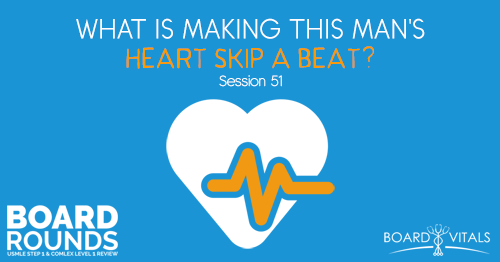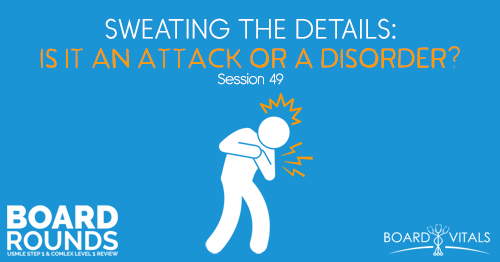[smart_track_player url=”http://traffic.libsyn.com/boardroundsone/br38.mp3″ color=”004075″ title=”USMLE and COMLEX Prep: Acute Renal Failure” ]

Session 38
A 52-year-old female with renal failure has perioral numbness, paresthesias of the hands and feet, and muscle cramps. What metabolic findings might we expect?
Dr. Mike Natter from BoardVitals joins us as we discuss another interesting case. They have thousands of questions on their database. They’ve got you covered. Save 15% by using the promo code BOARDROUNDS.
Listen to this podcast episode with the player above, or keep reading for the highlights and takeaway points.
[02:52] Question of the Week
A 52-year-old female who developed acute renal failure has a metabolic abnormality associated with perioral numbness, paresthesias of the hands and feet, and muscle cramps. Trousseau’s sign and Chvostek’s sign are also present.
In addition to the metabolic abnormality accounting to this patient’s symptoms, what other metabolic finding is likely to be present?
(A) Hyperphosphatemia
(B) Decreased parathyroid hormone (PTH)
(C) Increased sensitivity to 125 dihydroxy Vitamin D
(D) Hyponatremia
(E) Metabolic alkalosis
[03:45] Thought Process
We’re going to have issues with everything in our body because the kidneys are not doing their job. That’s why we have dialysis to help get stuff back to normal.
First off, we have to understand those abovementioned terms. There’s something out of whack here that’s causing the nerve to freak out and Chvostek’s signs and Trousseau’s sign are signs of that.
It’s important to go back to the stem. All those symptoms mentioned are very specific to hypo or low calcium. Calcium is needed for muscle contraction. If you had any disruption or low calcium, you’re going to see a lot of these signs.
[05:15] Definition of Terms
Trousseau’s sign is when you tap right on the facial nerve by your ear, you will see lateral muscle twitching because of the hypocalcemia. This is not often done in the clinic but it’s something worth noting. Maybe for some reason, your lab is taking longer to come back and you suspect it then you can go down this road.
Physical findings for hypocalcemia of perioral numbness would have very high sensitivity as well. These are interesting symptoms pointing us that way.
[09:44] Explaining the Mechanism to Arrive at the Correct Answer
We know from the stem that this patient has renal failure. We can assume that things are related to calcium. Think of PTH, Vitamin D, and phosphorus because they all relate to levels of calcium if things are working normally. There’s this beautiful negative feedback seen on the endocrine system.
'We can assume that things are related to calcium.'Click To TweetPTH found in the parathryoid glands have receptors. When your calcium is low, the PTH is turned up. Some people remember PTH as phosphorus-trashing hormones. When the PTH is turned on at high levels, it’s telling the kidney to kick out phosphorus. In exchange, you’re able to have high levels of serum calcium.
If your kidneys aren’t working, then even if PTH is very high, the phosphorus can’t be excreted. This is often seen in chronic kidney disease because of its negative feedback. You’re going to actually have higher levels of phosphorus so kidneys can’t get rid of it.
Meanwhile, phosphorus binds with serum calcium. So the free calcium floating in the blood to help you do things like muscle contraction is now being bound up.
As a result, the body is seeing much less calcium. So there’s much lower hypocalcemia in serum because we’re binding the phosphorus since it can’t get released by the kidneys. Because of this, we have hyperphosphatemia as the correct answer.
[11:55] Understanding the Other Answer Choices
Decreased parathyroid hormone (PTH) is the opposite because of negative feedback in the system. There is low calcium so you expect the PTH to be high. We also expect it to be chronically elevated in folks that have end-stage renal disease because you’ve kinked the negative feedback loop. So it’s always going to be on.
For increased sensitivity to 125 dihydroxy Vitamin D, one of the areas of sensitivity for Vitamin D would be at the kidney level. But at this point, the kidneys are broken. So it’s not going to be more sensitive if it’s broken.
Hyponatremia could be seen in renal disease especially if you are retaining a lot of fluid. Your body is not urinating. And when you’re retaining a lot of fluid, you can dilute the salt out in your system. So while this answer choice is not necessarily wrong, the context where the question is trying to get at, this is not the most right answer.
Hence, sodium, in this case, is not particularly relevant in this one area. But to say someone with end-stage renal disease can be hyponatremic is definitely correct. Just focus on the stem since they’re trying to guide you into the calcium balance here.
'Just keep in mind that you want to answer in the context of the stem.'Click To TweetFor metabolic alkalosis, this is not typical in the renal disease because you’re, in fact, going to see the opposite, which is metabolic acidosis. There are a lot of metabolic derangements that you may encounter. Again, within the context of this question, the acid-base balance is not specifically relevant to the calcium here.
Links:
BoardVitals (Save 15% by using the promo code BOARDROUNDS.)
Listen to Other Episodes
[smart_podcast_player url=”http://medicalschoolhq.libsyn.com/rss” color=”004075″ show_name=”The Premed Years” ]
SEARCH SITE
LISTEN FOR FREE











